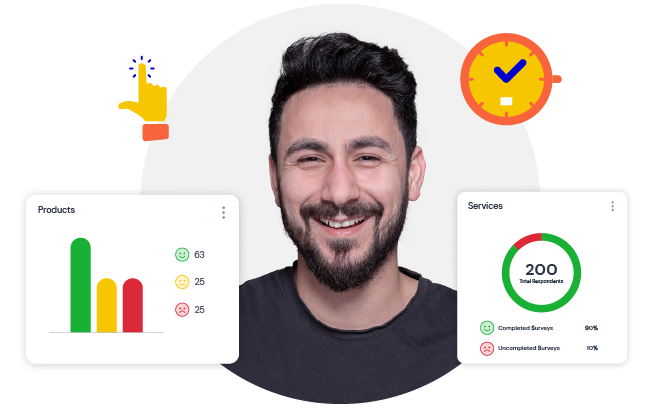When starting a business, or fighting to keep one alive, market research is crucial. When done correctly, it gives valuable insights that help connect you with your customer base. With some time and effort, you can determine what your customers need, value, and love in a business.
But where do you go to do market research? In other words, how do you build a target audience from whom you can gather insights? In this post, we discuss the widely-employed purposive sampling method – including what it is, why it works, and you can use it to build a target audience and start gathering insights today.
What is Purposive Sampling?
When you’re devising a marketing campaign, market sampling is vital. It’s used to secure a reasonably accurate evaluation of your audience by engaging a specific portion of it. Sampling gives a good look at a group without the hassle of asking everyone in it how they feel.
Sometimes called judgmental, selective, or subjective sampling, purposive sampling is a non-probabilistic market research technique. There’s an important distinction to consider when evaluating the best technique for you:
- Probabilistic: Techniques that are “probabilistic” give individuals similar nonzero odds of being selected. It’s also random – while the subjects have the same likelihood of being chosen, the selections are never predetermined.
- Non-Probabilistic: In non-probabilistic techniques, one or both of two concepts may be true. Firstly, the probability of selection isn’t known, meaning some candidates will have a higher chance of selection than others. Secondly, the probability will be 0% for some individuals.
Purposive sampling is non-probabilistic because potential candidates are thoughtfully chosen based on target audience criteria. Subjective factors determine who should be included in the sample – shared characteristics, for example – which will eliminate portions of the population. It’s used for testing specific target audiences quickly.
Purposive Sampling vs. Convenience Sampling
Because purposive and convenience sampling are both non-probabilistic sampling methods, they’re often mistaken to be the same, or at least similar enough to be used interchangeably.
They’re not. Both convenience and purposive sampling have unique applications. Convenience sampling grabs whoever is closest to the researcher; purposive sampling depends on predetermined criteria. Convenience sampling is fast, easy, and cheap to conduct as it utilizes existing traffic; purposive sampling requires a little strategy and tact to reach intended candidates.

Purposive Sampling Types and Uses
Purposive sampling should be used when gathering specific information from particular audiences. Because specific criteria are required, irrelevant responses are filtered out to give you a laser-focused look at your target audience.
There are seven types of purposive sampling. One or more of these types may be necessary to get you the best information. Consider the purpose of your market study to determine which are best for you.
- Total Population Sampling: When the entire audience – sharing one or more characteristics – is chosen. This is helpful in breaking large audiences into manageable portions, each with a specific classification. If the target audience is women, create specialized categories – ethnicity, age, sexual orientation, family status, income, etc.
- Expert Sampling: Used when gaining information that’s rooted in a specific type of expertise. This is great for engaging niche groups, or when you’re trying to gain an initial understanding of a topic. If, for whatever reason, you’re attempting to market to the National Button Society, expert sampling gives key insight into what button aficionados value.
- Typical Case: Examining how a product or trend made an impact on the “average” customer. Determining specifics about their experience helps you understand the values and routines of the grand majority or largest possible client base.
- Extreme Case: For every audience, there’s a large portion of “typical” cases. Then there are those whose behaviors are extreme enough to set them apart. Are some people spending considerably more or less than your average customer? Find out why by examining just the outliers.
- Critical Case: Used when just one case type is chosen to establish the “average,” with the assumption that the insights can be applied to other similar situations. Conducting a study at a midwestern gas station determines who is buying what. This gives insights that can generally be applied to midwestern gas stations in general.
- Homogenous: Choosing identical characteristics to determine a sampling group. It is especially helpful to determine interest among specific audiences. For example, are female college students in Ohio interested in football? Maybe. Based on responses to homogenous case sampling, future directions for your sports merchandise company become clearer.
- Heterogenous: Great as an early-stage market research option. Heterogenous sampling seeks to engage diverse subjects to get a view of the general public. Do people recognize your brand? Do they associate your logo with what you actually sell? What groups are more aware, and what groups should be targeted more effectively?
Pros of Purposive Sampling
There’s so much value in purposive sampling – it’s a favorite for a reason.
- Time and Cost Efficiency: Because the pool of candidates is smaller, purposive sampling requires far less time, money, and effort to conduct. It’s a perfect-fit system – you only pay for the engagement you need.
- You Get a Lot for A Little: Even if the investment in your purposive sampling study is small, it doesn’t mean that the amount or value of information has to be. Purposive sampling tends to give higher-quality information that’s specific to your needs by generally filtering out response bias.
- Extremely Versatile: From the examples explained above, purposive sampling can be applied to several diverse cases. Better yet, a homebrewed combination of many types results in even more specific and valuable information.
- Quality Responses: You’re far more likely to come away with quality responses from purposive sampling. This is because you’re able to collect a lot of data from a smaller number of committed respondents that are, in their own way, experts in their fields. Who is going to know more about driving trucks than truck drivers?
- Shrink the Margin of Error: Because of the specific criteria, only the best-fit candidates make the cut. The information that comes in will be completely relevant to the study and more accurately reflective of the audience due to the increased quality of responses.
Cons of Purposive Sampling
No method of market research or sampling is without drawbacks. Being aware of the issues can help you see problems coming and learn to solve them. Consider this a preemptive strike against an invalid study or failed marketing campaign built on incorrect data.
- Subgroup Exclusion: Purposive sampling may – either accidentally or by design – eliminate important subgroups from the study. If you’re surveying college students, does your study account for part-time students? Older students who resumed higher education? Disabled students? If you’re running a purposive sampling study, ensure that everybody in your chosen audience is accounted for – you’ll be thankful you did.
- Not Effective on A Large Scale: Even total population sampling has its limitations before the results are too diverse, scattered, and specific to be useful. Purposive sampling is best used for smaller groups and specific niches – if your research scope is particularly large, purposive sampling may need to wait.
- Data Invalidation Risks: Because of the specificity, the validity of the results is questionable. Subgroup exclusion plays a part here, but so does the personal judgment of researchers. There’s often doubt about a small, specialized sample providing sufficient representation of the target audience. It’s hard to combat this, but preventing subgroup exclusion can boost the validity of your study’s representation.
- It’s Extremely Bias Heavy: Researcher bias is a greater risk with purposive sampling than convenience sampling. Your team is literally using personal judgment to choose candidates – subconscious bias is going to sneak in. While researcher bias is unavoidable, it can be drastically reduced by choosing a diverse and qualified team to plan, write, and conduct your study.
The CheckMarket Advantage
When you’re planning to conduct your purposive study, let CheckMarket give you a hand. We’re built to ask all your critical questions and secure actionable results. CheckMarket has powered countless surveys in 150 countries around the world, and we’ve seen it all. From providing bias-crushing survey templates to effortless survey distribution, we can help you get out in front of the common problems that trip up your marketing team.


Geef een antwoord